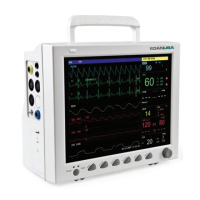Patient Monitor User Manual Monitoring ECG/ RESP
- 97 -
NOTE:
1 Interference from a non-grounded instrument near the patient and ESU interference
can cause inaccuracy of the waveform.
2 IEC/EN60601-1-2 (protection against radiation is 3 v/m) specifies that the electrical
field density exceeding 3 v/m may cause measurement error in various frequencies.
It is accordingly suggested that do not use equipment generating electrical radiation
near ECG/RESP monitoring devices.
3 The simultaneous use of cardiac pacemaker and other patient-connected equipment
may cause safety hazard.
4 If the pacemaker signals are beyond the claimed range, the heart rate may be
calculated incorrectly.
5 In the default settings of the monitor, the ECG waveforms are the first two waveforms
from top in the waveform area.
6 For measurements in or near the heart we recommend connecting the monitor to the
potential equalization system.
7 For protecting environment, the used electrodes must be recycled or disposed of
properly.
8 The patients can’t be monitored during ECG calibration.
13.3 Monitoring Procedure
13.3.1 Preparation
1. Prepare the patient's skin prior to placing the electrodes.
The skin is a poor conductor of electricity; therefore preparation of the patient's skin is
important to facilitate good electrode contact to skin.
Shave hair from sites, if necessary.
Wash sites thoroughly with soap and water. (Never use ether or pure alcohol, because
this increases skin impedance).
Rub the skin briskly to increase capillary blood flow in the tissues and remove skin
scurf and grease.
2. Attach clip or snap to electrodes prior to placement.
3. Put the electrodes on the patient. Before attaching, apply some conductive jelly on the
electrodes if the electrodes are not electrolyte self-supplied.
4. Connect the electrode lead to the patient's cable.
5. Make sure the monitor is ready with power supply.

